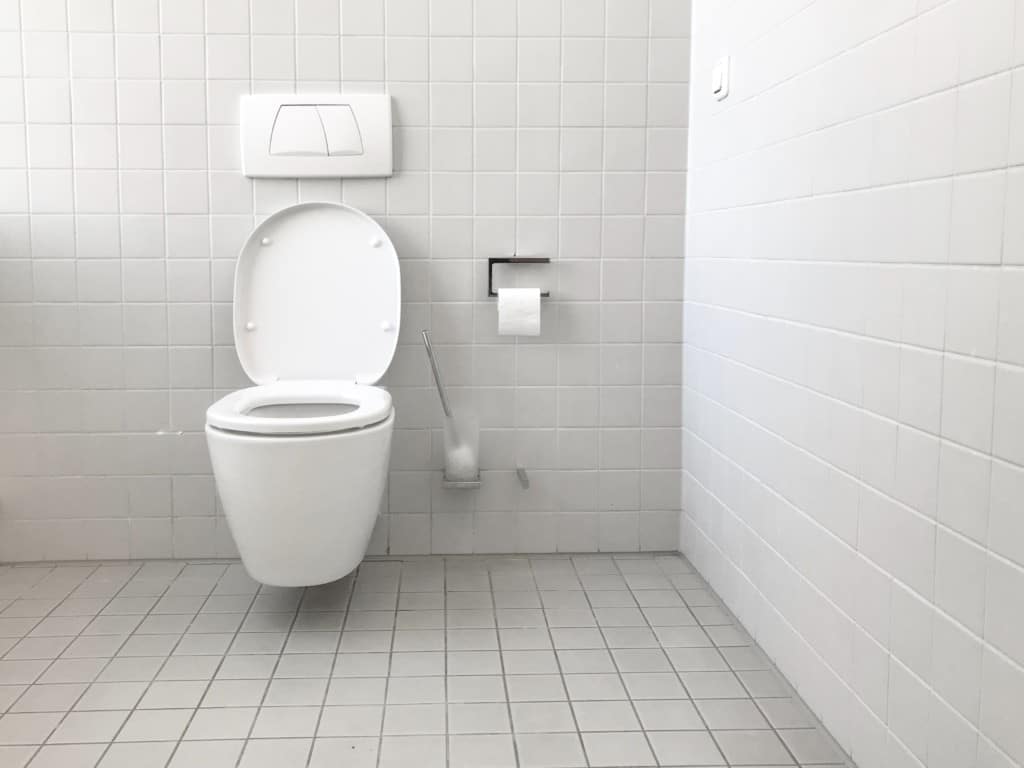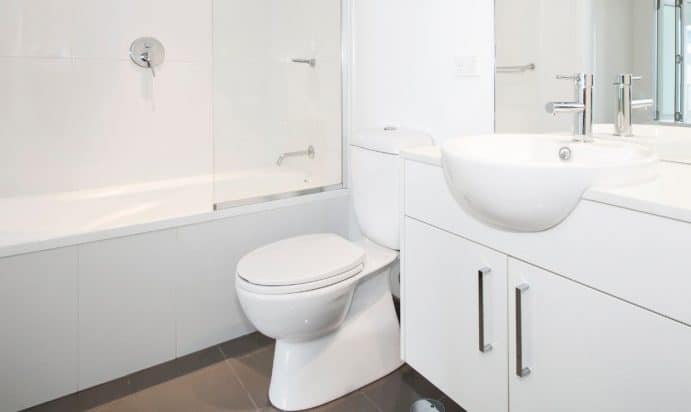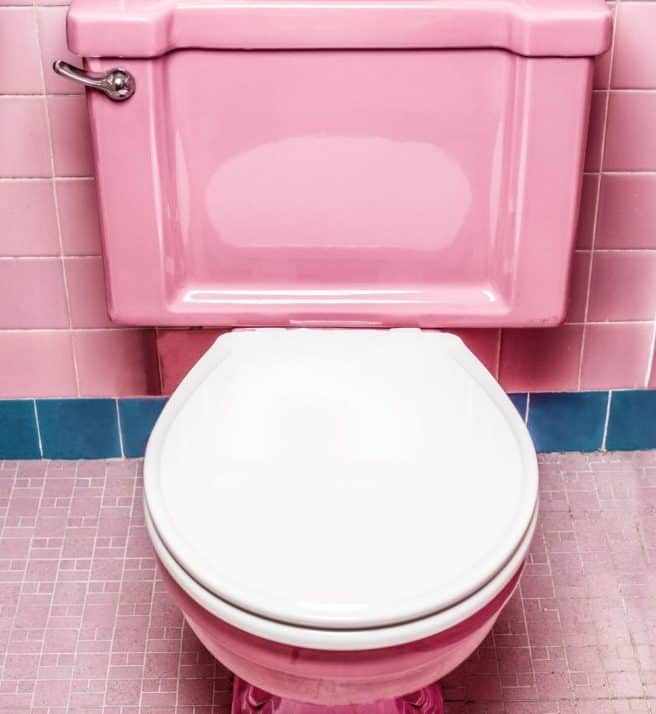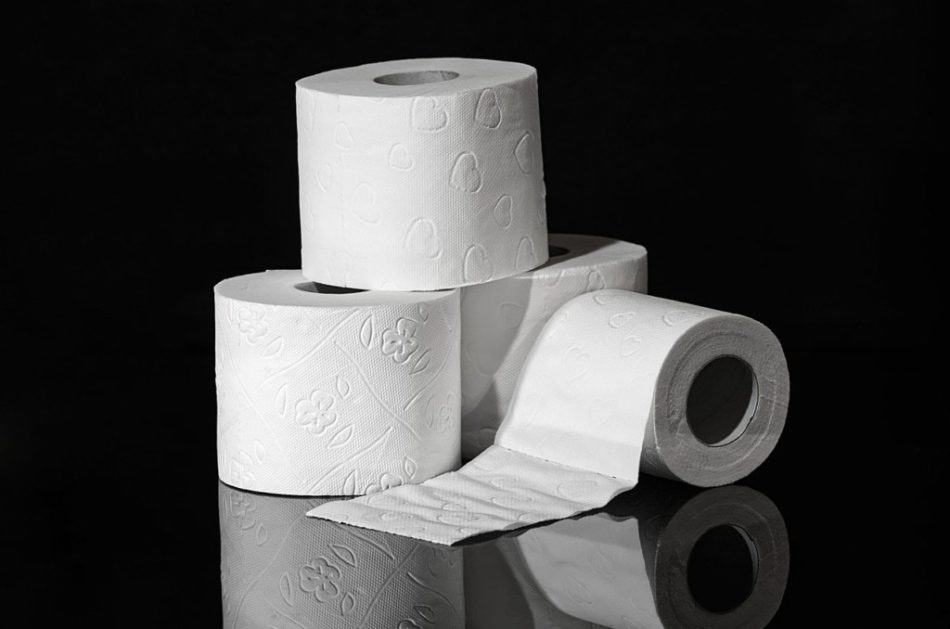
Toilets always seem to be white. And if you’re a curious person like me, then at some point you’ve probably wondered why toilets are white.
Toilets are white for several reasons. They are mostly made out of porcelain, and porcelain itself is white. White also represents cleanliness, and it makes it easy to see dirt. White toilets are also cheaper than colored toilets, and they provide a modern aesthetic.
There’s a lot more to know about the color of your toilet, including 5 fun facts exploring the reason behind this color of choice. Let’s dive in!
Table of Contents
Why are Toilets White?

1. Porcelain
The first reason toilets are white is because porcelain is white. That’s right, your toilet is called the porcelain throne because it is actually made out of porcelain.
Why is that?
For what we require toilets to do, it’s important that they’re made out of a strong durable material that will last a lifetime. Porcelain satisfies all those needs.
While you may be thinking porcelain is fragile because of things like porcelain dolls, it actually has great compressive strength. This means that, while dropping or hitting it with something may shatter it, pushing it down (e.g. you sitting on your toilet) will cause no damage.
Porcelain is also rustproof which is an invaluable attribute to something that holds water all the time.
2. Symbolizes Cleanliness
Another reason toilets are white is because that color is often associated with cleanliness.
This goes way back in our history. Nearly all mythologies and religions see white as representing innocence, purity, and cleanliness. This idea slowly seeped into all aspects of our life, including our bathrooms.
Imagine what you would think if you went into a bathroom and saw a brown toilet. You may suddenly not have to go to the bathroom.
We’re visual creatures and so we attribute a lot to how things look, toilets are no different. We want our bathrooms and toilets to look clean and neat. A quick and easy way to accomplish that is to have white surfaces.
3. Easy to See Dirt
Let’s be honest, toilets have a pretty gross job. And if we want to keep ourselves safe from all the bacteria that could be on our toilets, it’s important to know when our toilet needs cleaning.
Toilets being white makes it easy for us to tell when our toilets are dirty. It may seem gross, but it can keep us safe from bacteria if we keep our toilets the shiny white that they’re supposed to be.
4. Price
This should come as no surprise, toilets are white because it’s cheap.
Porcelain is naturally white, so nothing needs to be added to change its color. Toilet seats, however, can easily be a different color because a lot of toilet seats are made of plastic which is cheap to get in a different color (although different materials can affect how long a toilet seat lasts).
Keeping the porcelain the way it naturally looks keeps the price of toilets down. If you want to spruce up the look of your bathroom, maybe add a colored toilet seat to add a little pop of color.
5. Aesthetic
Like I mentioned earlier, we’re visual creatures and so we attribute a lot to the way things look.
White in bathrooms gives them a clean, sleek, modern appearance which makes them more attractive to people.
This is especially important in the real estate market. Modern, clean-looking bathrooms tend to sell at a higher price than others. Keeping your toilet white can help add to this aesthetic.
So, if you’re trying to sell your home or apartment, get rid of that black toilet seat and put in a white one, it may help more than you think.
The preferred design of homes and bathrooms is constantly changing, however, so we may see a shift in what people like. Be prepared for hot pink toilets, I see them in our future 🙂
When Toilets are Not White

While white toilets are the most common, you may occasionally see toilets around with different colors. Here’s why you might see them, and also why they’re rare.
Where Did They Go?
Colored toilets used to be all the rage in the 50s and 60s. This is because themed bathrooms were the preferred design of that period.
People would go to great lengths to ensure their bathrooms were a complete color theme. The main focal point of this color theme was the toilet. Toilets were made in pastel greens, pinks, purples, and blues.
As the world evolved, colored toilets and bathrooms slowly went out of style and were replaced by the now-common white toilet.
Where are They Now?
Although they’re not as common anymore, colored toilets are still out there.
If you see a colored toilet, then it’s probably going to be in a vintage home. Whether they were restored to their original glory or someone created the vintage look from scratch, vintage color-themed bathrooms are keeping colored toilets alive.
Colors that are becoming more common are black and stainless steel. These are also seen as very modern and so are used in places that want to increase their sleek, modern appeal.
You can still buy vintage-colored toilets. But, they are increasingly hard to find because less and less people are looking for them. And, as fewer people are buying them, they are becoming more expensive.
But, as design preferences come and go, we might see a comeback from the colored toilet in the future. I guess we’ll just have to wait and see.
One thing that probably isn’t going to change anytime soon, is toilet paper.
Why is Toilet Paper White?

If you’re already wondering why toilets are white, then you might also be wondering why toilet paper is white. Well, it mostly has to do with the process of making toilet paper.
How it’s Made
Surprisingly, a lot of toilet paper is made using recycled paper. If you’re ever wondering if you should recycle an old pile of papers, the answer is yes, you might end up using it again in the future.
They grind up the paper into a pulp, then they remove the ink from this paper slurry.
Removing the ink alone helps to turn the paper white and I think we can agree that we don’t want our bathroom tissue to contain ink.
The paper pulp is then bleached white using non-harmful chemicals. This gives the paper it’s pristine white look.
In order to make toilet paper colored, from here, the company would have to add in dye to achieve the desired color. This can be expensive depending on how vibrant the color is.
Price
Just like with toilets, it’s cheaper to keep the toilet paper its natural color.
In case you didn’t know, you can still buy colored toilet paper today, but these rolls are much more expensive than the common white color.
Keeping the paper its regular color means they don’t have to add any dyes or extra materials that increase the cost.
So, white toilet paper all around.
Modern Design
Believe it or not, colored toilet paper used to be very common in the 50s and 60s. In this era, most bathrooms were color-themed.
Bathrooms would be completely one color or the other. Imagine, a bathroom completely pink or soft purple. Sounds kind of fun doesn’t it?
To make this color theme perfect, people would buy toilet paper that matched the color of their bathroom.
As we talked about earlier, modern bathrooms are almost always white and people prefer the modern, sleek look of today’s bathrooms. So, to keep the current color theme going, toilet paper is predominantly white.
If you’ve got a color-themed bathroom and you want toilet paper to match, don’t worry, you can still find colored toilet paper online. But, it’s a little pricey.
Related Questions
What are toilets made of?
Most toilets are made out of porcelain. This is because porcelain is strong, easy to clean, and rustproof, making it the perfect material for toilets. Porcelain toilets are also long-lasting and can last up to 50 years.
Why are toilets made of porcelain?
Toilets are made of porcelain for a few reasons. First, porcelain has great compressive strength, meaning it holds up well when a weight is placed on top of it. Porcelain is also very durable and rustproof which is why it’s used in a variety of bathroom fixtures, not just toilets.
